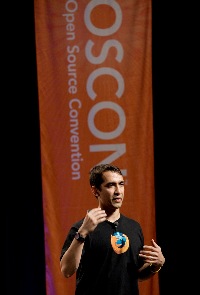Author: Nathan Willis
Last month at O’Reilly’s Open Source Convention (OSCON), it seemed like Microsoft was everywhere you looked, avouching its interest in open source. Thanks to the company’s history — including some very recent history — a great many in the open source community viewed the company’s presence with mistrust, suspicious of Redmond’s motives and apprehensive of what would follow. Surely Microsoft must want something, so what is it?
Monday, Microsoft sponsored the Participate 08 panel. Wednesday, Hank Janssen presented a session about Microsoft’s Open Source Software Lab. Thursday, John Lam spoke about IronRuby, and Sam Ramji made an appearance at the SourceForge.net Community Choice Awards. Friday, Sara Ford gave a talk about the open source “ecosystem,” and Sam Ramji delivered one of the morning keynotes, decked out in a crisp, stylish Firefox T-shirt.
And that was in addition to the assorted advertising and paraphernalia that comes with anteing up as an event sponsor.
Microsoft repeated loud and clear its “we like open source” message. Its speakers touted company projects like IronRuby and Windows Installer XML, the company’s open source project portal CodePlex, and Friday’s announcement that the company was joining the Apache Foundation.
Suspicion
I’m no mind reader, but the reception of the audiences at the events I was able to attend in person — in particular the Participate 08 panel and the Ramji keynote — tell me that many in the OSCON crowd weren’t taking Microsoft’s story at face value. That skepticism stems from two roots. First, it is far removed from the company’s historical views of open source as a “cancer” and “anti-American.” Second, the company has a history of “embracing and extending” competing technologies in a manner that crushes them.
Microsoft clearly has not changed its opinion of open source without a reason, and whatever that reason is, the change must be one that Microsoft’s management has decided is advantageous. So what is the play? What does the company hope to gain?
Conspiracy theorists will say that Redmond’s goal is to destroy open source, either by poisoning it from the inside or by co-opting it. There is a subtle difference between those scenarios, hidden in the terminology itself. Understanding that is the key to figuring out what Microsoft is really after.
Send in the nouns
The issue is that “destroying open source by poisoning it from the inside” and “destroying open source by co-opting it” muddle what the term open source means. “Open source” could mean the open source community, the open source development model, or the stack of open source software that competes head-to-head with Microsoft’s.
The only one that Microsoft cares anything about is the third. The open source development model doesn’t compete with Microsoft directly, but the open source stack does: Linux, Apache, Postgres, and OpenOffice.org, to name a few competitive products. The open source community is important to Redmond only in that it develops the platform that competes against Windows, Internet Explorer, Internet Information Server, SQL Server, and Microsoft Office.
For me, the most telling comment from Microsoft at OSCON came from Bryan Kirschner at Monday’s Participate 08 panel. Microsoft sees its platform losing mindshare with up-and-coming developers who find the open source platform more appealing.
The company wants to lure those developers back. Its open source play is aimed squarely at them, and at independent software vendors (ISV). They mean potential sales, and Microsoft has embraced the open source development model in order to tempt them away from the open source platform and over to the Windows platform.
Kirschner’s sentiment is reinforced by what Microsoft’s project hosting site and portal site are all about: development tools, such as integrated development environments, installers, and build tools.
So yes, Microsoft is definitely out to get something by showing off its love of “open source” — it is out to get developers. By leaving off the nouns whenever it mentions “open source” it may sound like Redmond has decided to be friends with the open source community, but don’t be fooled. It is interested in the open source development model because ISVs and other potential customers like it, and it still views the open source stack as the major competitor and threat to its own product platform.
Will this play work? Running the initiative does not cost the company much money (see, open source development does mean low TCO!) and it is sure to attract some developers; how many depends on how well the company executes, and how well the open source community executes at the same time.
I am not convinced by the logic of any of the conspiracy theories about Microsoft sidling up to the open source community in order to subvert and destroy it; they are too convoluted when straightforward attacks are much simpler. Its words and actions at OSCON 2008 are all candid, direct attempts to lure ISVs and developer talent to Microsoft’s own product line. Given that, it hardly makes a difference whether Redmond’s imprecise use of the words “open source” is intended to blur the distinction between the development model, the community, and the software stack.
Categories:
- Commentary
- Windows & Microsoft
- Open Source



